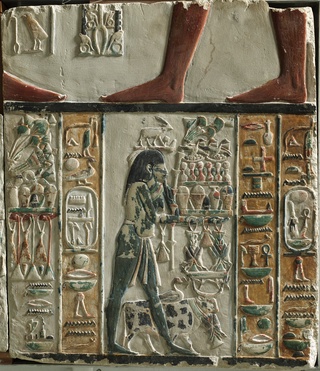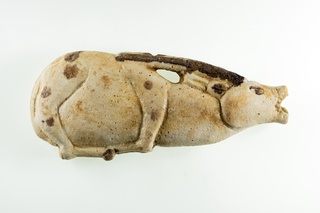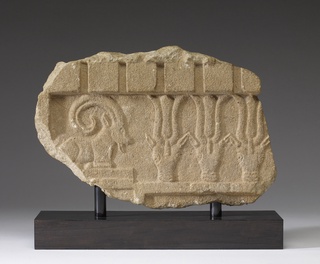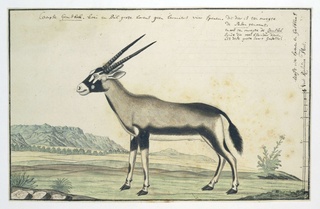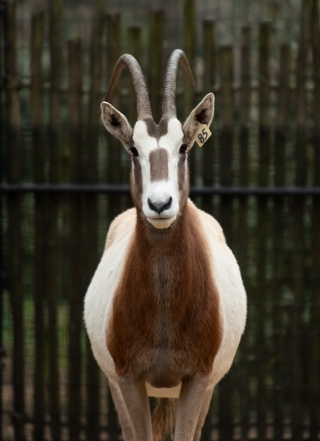The Scimitar-Horned Oryx: To Extinction and Back
By Max Levin•February 2023•7 Minute Read
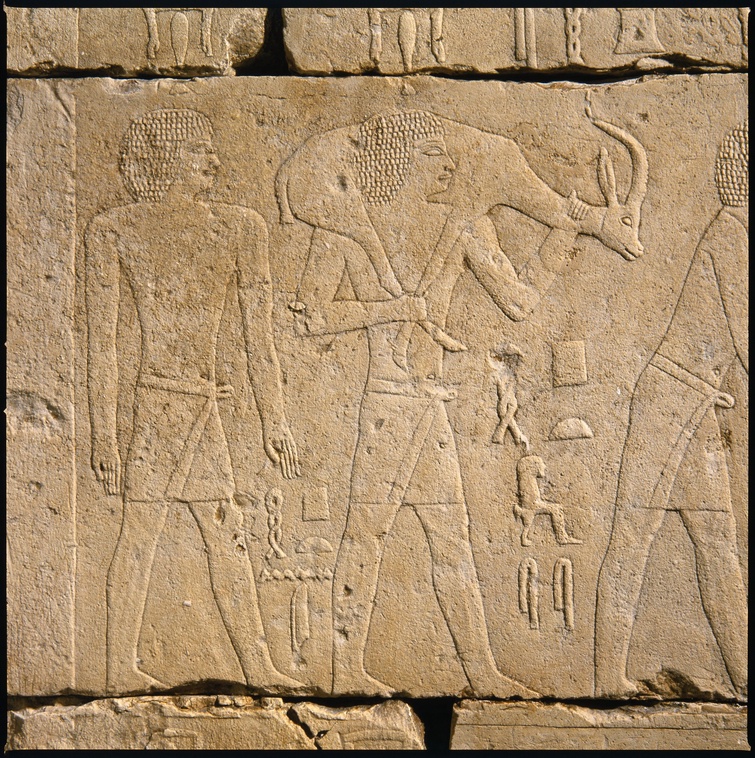
Tomb Chapel of Raemkai: East Wall, ca. 2446–2389 B.C., Metropolitan Museum of Art. Public Domain.
The oryx is an ancient desert-dwelling antelope that was important in the history, mythology, art, and ecosystems of the Sahara and sub-Sahara. Extinction of the scimitar-horned oryx in the wild prompted ambitious efforts to bring the animal back from the brink. An ongoing process aims to foster sustainable populations of scimitar-horned oryx in preserves in Chad.
The scimitar-horned oryx is a magnificent herding antelope that can stand 1.4 meters (4.6 feet) tall at the shoulder and survive for months without drinking water.1 The species is named for its two ridged, backwards-curving horns, which can grow to several feet long. Their hooves evolved to manage walking in sand, while the ability of all oryx to tolerate drought aids their survival in harsh desert conditions.
The oryx’s importance in history, mythology, and sub-Saharan ecosystems led to their depiction in art. It is even possible that an oryx with a broken horn was one inspiration for the legend of the unicorn.2 For millennia, scimitar-horned oryx traversed long distances across the subdesert landscapes of North Africa in groups numbering in the hundreds. Eventually, overhunting, drought, and habitat destruction led to endangerment. In 2000, the scimitar-horned oryx became extinct in the wild. But a multinational effort has preserved healthy oryx in captivity and reintroduced them into hospitable habitats in Chad, where it roams free once more.3
In Ancient Egypt
As long ago as the third millennium BCE, ancient Egypt was divided into 42 districts known in English as nomes.4 The 16th nome in Upper Egypt was the Oryx nome. Figurations of oryx are found in archaeological remains from this district.
M. W. Blackden, The Symbol of the Nome from the South Wall of Tomb No. 3, 1891. In Archaeological Survey of Egypt, 1896. Public domain.
Tombs and storage vessels in the Oryx nome have been discovered in the ancient burial ground of Beni Hasan, between present-day Asyut and Memphis in Egypt. Along with the Oryx iconography, information about the local governors known as nomarchs is engraved on them. The Oryx nome existed along the Nile River among other animal-named regions such as Bull, Cobra, Fish, and Crocodile. Other nomes included Prospering Scepter, Knife, Prince of the North, and Travelers Land.
Set (or Seth) was the Egyptian god of deserts, disorder, and violence. He was often represented in canine form or as an oryx. In mythology, Set was said to have killed his brother Osiris, god of fertility, agriculture, life, and death. Osiris was then resurrected long enough for he and his wife Isis to conceive a son, Horus. Horus, the god of kinship and the sky, is one of the most important Egyptian deities. As the enemy of Osiris and Horus, Set in oryx form was often depicted with his legs and horns bound.
Ancient Egyptians were probably the first to begin to domesticate and butcher the scimitar oryx for food.
Three Taxonomies
According to modern taxonomy, the German naturalist Lorenz Oken was the first to describe the scimitar oryx in 1816, naming it Oryx algazel. Other species of oryx are the Arabian oryx (Oryx leucoryx), the East African oryx (Oryx beisa), and the oryx found in southern Africa, the gemsbok (Oryx gazella).5 The scimitar-horned oryx is the only related species with curved horns.
Of these oryx species, the Arabian oryx and scimitar-horned oryx face the greatest threat of endangerment and extinction. Yet they are both powerfully built, highly specialized creatures.
Adaptation to the Desert
As desert dwellers with limited access to moisture, oryxes have become supremely adapted to dry conditions. They are known to survive for months without drinking water by consuming the water inside plants.6
Here, the oryx chews greens in a fragment of a furniture plaque. This depiction of the resilient herbivore signals its vital role in the food chain. Oryx keep plants from becoming overgrown and provide a food source for desert carnivores such as lions and hyenas. Beyond digestive capability, the scimitar-horned oryx is noted for its ability to detect slight variations in air humidity from miles away.7
Contemporary Challenges
Unfortunately, even the oryx’s evolutionary suitability to arid desertscapes left them on dangerous footing as weather patterns and civilizations shifted over the centuries. Climate change, competition with domestic livestock, drought, over-hunting, and habitat destruction all contributed to dwindling oryx throughout the 20th century.8
Early Efforts at Recovery
In the 1960s, a wildlife trader captured 50 wild oryx in Chad and sold them to zoos in Europe and North America.9 This produced the populations of captive scimitar oryx currently living in zoos and other wildlife preserves around the world. The Smithsonian’s National Zoo and Conservation Biology Institute developed groundbreaking artificial insemination techniques for scimitar-horned oryx. During the 1980s, war further decimated the oryx population in Chad, and the last known photograph of a scimitar-horned oryx in the wild was taken in 1980, in Niger.10 In 2000, the scimitar horned oryx was declared extinct outside of captivity.11
Return to the Wild
Meanwhile, the success of captive breeding and coordinated international interest in returning the scimitar oryx to its natural range led to the development of a “global herd” in Abu Dhabi, led by a consortium including the Environmental Agency in Abu Dhabi, the Sahara Conservation Fund, the Zoological Society of London, and the Smithsonian in the United States.12 This herd was curated to be genetically diverse and allowed an international team of scientists to gain training in animal husbandry and wildlife maintenance. These extreme efforts were taken to make for the most successful possible reintroduction of the scimitar-horned oryx to its native habitat.
In 2016, 25 of the scimitar-horned oryx from the global herd were flown to Chad, where they were tagged for monitoring and released into Ouadi Rimé-Ouadi Achim Game Reserve, a protected area set up specifically for the conservation desert species including the oryx. As of 2022, there are almost 100 scimitar-horned oryx in Chad, including 18 wild-born calves.13 The hope is that national anti-poaching efforts and collaborative approaches to monitoring and protecting the oryx in the preserve will lead to a healthy, uncontacted population of oryx in Chad and beyond.
Other animals
Globally, extinction of flora and fauna are occurring at rates from 1,000 to 10,000 times higher than the natural or background extinction rate.14 Unlike the fortunate oryx, many of these species do not have worldwide support or local infrastructure in place to monitor and actively protect them against their complete disappearance. A few, like the northern white rhinoceros, are the subject of advanced cryogenic and embryonic research to produce healthy new rhinos after their species has technically become extinct.15 Other species have quietly vanished from Earth. We may not even know they were here until we find their fossils or fragments of sculptures in tombs or the like that tell of their importance to a culture or climate.
Citations
“Scimitar-Horned Oryx.” The Smithsonian's National Zoo & Conservation Biology Institute, 21 June 2021, https://nationalzoo.si.edu/animals/scimitar-horned-oryx. Accessed 6 June 2022.
“Scimitar-Horned Oryx.”
“Chad Oryx Reintroduction Project.” Sahara Conservation, https://saharaconservation.org/scimitar-horned-oryx/. 6 June 2022.
“List of Provinces ('Nomes') of Ancient Egypt.” Provinces of Egypt, University College London, https://www.ucl.ac.uk/museums-static/digitalegypt/geo/index.html. Accessed 6 June 2022.
Estes, Richard. “Oryx.” Encyclopædia Britannica, https://www.britannica.com/animal/oryx. Accessed 6 June 2022.
“Scimitar-Horned Oryx.”
“Scimitar-Horned Oryx.”
“Scimitar-Horned Oryx.”
“Chad Oryx Reintroduction Project.”
“Scimitar-Horned Oryx.”
“Quarter of Antelope Species in Danger of Extinction.” IUCN, 8 Nov. 2019, https://www.iucn.org/content/quarter-antelope-species-danger-extinction. Accessed 6 June 2022.
“Chad Oryx Reintroduction Project.”
“Chad Oryx Reintroduction Project.”
“How Many Species Are We Losing?” World Wildlife Fund, https://wwf.panda.org/discover/our_focus/biodiversity/biodiversity/. Accessed 6 June 2022.
“BioRescue Creates Another Three Northern White Rhino Embryos, Bringing Total to 12.” Eurasia Review, 29 July 2021, https://www.eurasiareview.com/30072021-biorescue-creates-another-three-northern-white-rhino-embryos-bringing-total-to-12/. Accessed 6 June 2022.
